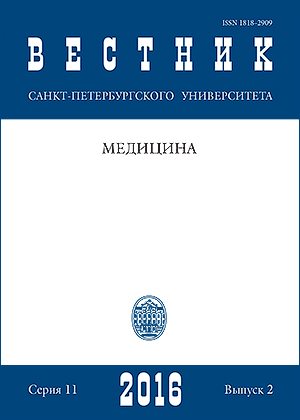EPONYMOUS AND NO LONGER ANONYMOUS: HARD LIFE AND LONG FAME OF RUSSIAN PHYSICIANS. PROCEEDING I: WHO WAS DOCTOR ZIVERT?
DOI:
https://doi.org/10.21638/11701/spbu11.2016.209Abstract
Th e article is devoted to biographies of three Russian physicians of the Silver Age (a period in the History of Russian culture between 1890 and 1917). Th ey made an early, signifi cant and internationally recognized contribution to medical science and became eponymous, although the social disasters of the twentieth century were to deeply impact their subsequent lives and careers, and so their role has been obscured in the global medical community. Th e proceeding is devoted to biography and academic achievements of A-F. K. Siewert (Zivert) (1872–1922), known for the fi rst description of the hereditary dyskinesia of cilia (as a triad of: situs inversus of the viscera, abnormal frontal sinuses producing sinusitis and bronchiectasis). The subsequent proceedings will cover also biographies of his contemporaries: S. S. Abramov, the discoverer of primary idiopathic myocarditis, and N. I. Taratynov, who was the first to describe a local form of histiocytosis X (solitary eosinophilic granuloma). The contribution of these scientists to Medicine is reviewed in context of a historical epoch, against the background of their diff erent individual social choices and the fates of their families. Besides their eponymous descriptions, other medical priorities of these scholars are analyzed. Some previously unpublished materials from their family archives are presented, which witness to the possibility of a hitherto unknown prototype for the main hero of the novel Doctor Zhivago novel by Boris Pasternak and for the probable priorities of doctor Zivert in the formulation of the active diastole concept, or doctor Abramov in the description of dilated cardiomyopathy. Th e factors facilitating rapid development of theoretical and practical Medicine in imperial Russia of late 20th and early 21st centuries are discussed. One of them defi nitely was the factor of broad contacts between Russian physicians of that period and their Western European colleagues, free from any linguistic, economical, political or bureaucratic restrictions. The conclusion of the author is that in any epoch, even the most cruel and unfavorable one, creative activity is a path to social immortality.Refs 30. Figs 2.
Keywords:
Alfons-Ferdinand-Julius Karlovich Siewert, Nikolai Ivanovich Taratynov, Sergei Semionovich Abramov, Zivert–Kartagener triad, Taratynov’s disease, Abramov-Fiedler myocarditis, History of Medicine, Kiev school of internists, Germans in Russia
Downloads
References
References
Downloads
Published
How to Cite
Issue
Section
License
Articles of "Vestnik of Saint Petersburg University. Medicine" are open access distributed under the terms of the License Agreement with Saint Petersburg State University, which permits to the authors unrestricted distribution and self-archiving free of charge.




